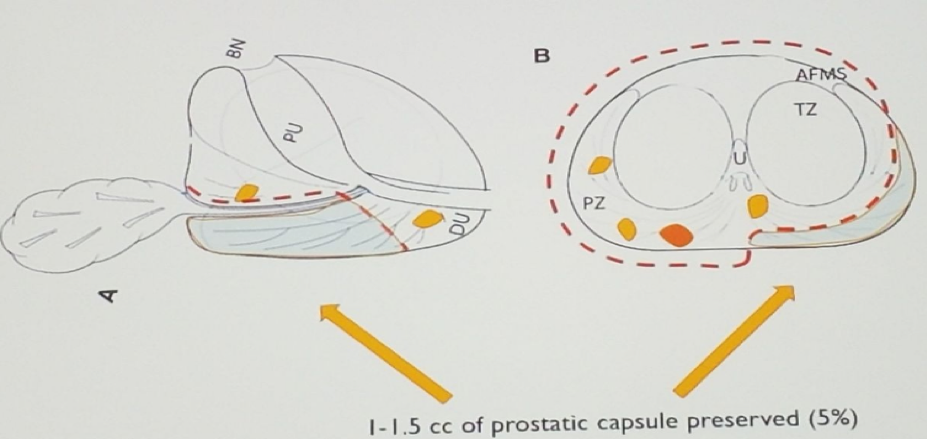Some studies have shown that prostatic nerves may be all around the peripheral zone of the prostate (Figure 1) and not only in the neurovascular bundle. Biochemical analysis revealed nitric oxidase synthase activity in the human prostate with a greater amount in the peripheral zone than in the transition zone, correlated with erectile function. Therefore, focal therapy for localized and multifocal prostate cancer will result in less damage to the neurovascular fibers all around the prostate.
Partial prostatectomy for anterior cancer has been described and published with overall good short term oncological and functional outcomes. [1] Dr. Menon suggests, that in the same manner as organ preserving surgery for breast cancer has been adopted, there is no reason it should not be adopted in prostate.
Dr. Menon describe a study his group was conducting, selecting patients with Gleason 7 or less, with clinical stage T2a or less. Dr. Menon described a procedure of precision prostatectomy, where some of the prostate is left and not the entire prostate as usual. Figure 2 demonstrates the cutting area of the prostate. The results demonstrate excellent outcomes with good continence and very good sexual function. These results are considerably better than HIFU results.
Dr. Menon explains that the success of the procedure is due to several reasons:
- The prostate has no true capsule
- The false capsule is an angionerunal tissue compressed by the ingrown prostatic cells.
- Cancers are located in the peripheral zone because adrenergic signaling may initiate tumorigenesis.
Figure 1: Neurovascular tissue of the prostate

Figure 2 - Precision prostatectomy:

Presented by: M. Menon, MD, Detroit, US
References:
1. Villers et al. Robot-assisted partial prostatectomy for anterior prostate cancer: a step-by-step guide. BJUI, 2017; 119 (6):968
Written by: Hanan Goldberg, MD, Urologic Oncology Fellow (SUO), University of Toronto, Princess Margaret Cancer Centre, twitter: @GoldbergHanan at the 2018 European Association of Urology Meeting EAU18, 16-20 March, 2018 Copenhagen, Denmark


